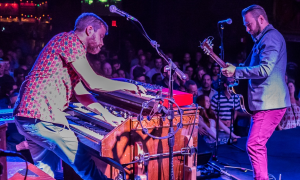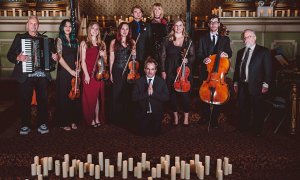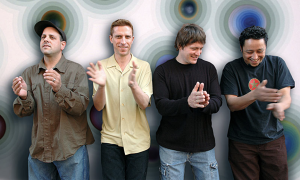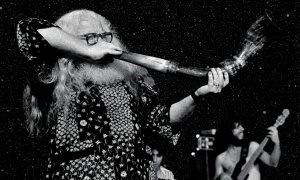Home » Jazz Articles » From the Inside Out » Thanks for Covering Every Corner
Thanks for Covering Every Corner
It's hard to believe that you've already been gone for sixteen years now. And I know you don't miss much from your perch up there, but I wanted to make sure that you knew what we've been doing with your music down here, in case you and Hendrix have been busy working out changes with Monk or something and missed it.
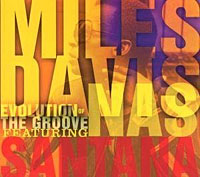 In August, Columbia/Legacy released Evolution of the Groove. Your nephew Vince Wilburn Jr. played drums and did some programming and was one of its executive producers. It strings together five titles pretty representative of your work, or at least a major chronology of it, by cutting new rhythm tracks, a rap by Nas and a wicked Santana guitar solo into samples of your original music and recordings of your voice.
In August, Columbia/Legacy released Evolution of the Groove. Your nephew Vince Wilburn Jr. played drums and did some programming and was one of its executive producers. It strings together five titles pretty representative of your work, or at least a major chronology of it, by cutting new rhythm tracks, a rap by Nas and a wicked Santana guitar solo into samples of your original music and recordings of your voice.
It is extremely cool to hear your voice enthusing "Boom boom boom!" and "Play it on one, man, just keep it on the one" (one time looped in just as the beat downshifts from one to four—sly touch) within your own tunes. After a brief "Freddie Freeloader" (Kind of Blue, '59) intro, its centerpiece forms from collages of "Freedom Jazz Dance" (Miles Smiles, '66) with your nephew, Victor Bailey, Geri Allen and a tribute from trumpeter Olu Dara; and "It's About That Time" (In a Silent Way, '69), with a cut-in guitar solo from your friend Carlos Santana scorching the sky above while new and remixed rhythms crackle like dry underbrush below.
Texas blues guitarist Doyle Bramhall II then busts up your "Honky Tonk" joint (Get Up With It, '70) before touching down with your mysterious and shiny "Black Satin," which brings us up to On the Corner in '72.
You might have really liked Evolution of the Groove. Folks don't seem quite sure what to make of it: Some most likely hate it because there's a rapper on it, and some because it uses "old jazz" as its source material. Still other folks will like it because those others folks hate it. Still on the job, eh?
But Evolution of the Groove proved more than mere antagonism. It heralded Columbia/Legacy's subsequent The Complete 'On the Corner' Sessions released in September: six discs documenting sixteen sessions you recorded between March '72 through May '75, improvisational funk prototypes that comprised On the Corner ('72), Get Up With It ('74) and Big Fun ('74) plus two hours of previously unreleased music. You sound like an electronic Ellington, playing trumpet and organ through wah-wah pedals and orchestrating beauty and chaos from dozens of musicians. What an amazing circumstance for bassist Michael Henderson: Four drummers, five guitar players (including soul-jazz legend Cornell Dupree and Chess Records session ace Pete Cosey), five keyboard players and horn players, but one bassist — a 19-year-old from Motown studios in Detroit who never recorded a jazz record in his life, placed dead center in one of modern African American music's most notorious revolutions, orchestrated by one of its most controversial task masters. Henderson's bass seem to drill deep down through both the groove and your skull; it's often the only instrument you can readily hold onto. This young man knew his unique role in the midst of your electric tempest: "He just wanted me to be funky and an extended groove — a breakdown like you get in R&B after you finish the song. Except forget the song and just start with the breakdown. He wanted freestyle funk with a little bit of jazz in it and a feel so solid, so intense, people could dance to it a lot easier."
What an amazing circumstance for bassist Michael Henderson: Four drummers, five guitar players (including soul-jazz legend Cornell Dupree and Chess Records session ace Pete Cosey), five keyboard players and horn players, but one bassist — a 19-year-old from Motown studios in Detroit who never recorded a jazz record in his life, placed dead center in one of modern African American music's most notorious revolutions, orchestrated by one of its most controversial task masters. Henderson's bass seem to drill deep down through both the groove and your skull; it's often the only instrument you can readily hold onto. This young man knew his unique role in the midst of your electric tempest: "He just wanted me to be funky and an extended groove — a breakdown like you get in R&B after you finish the song. Except forget the song and just start with the breakdown. He wanted freestyle funk with a little bit of jazz in it and a feel so solid, so intense, people could dance to it a lot easier."
I know that you know, but it bears repeating: This ain't just knee deep, it is totally deep, sessions that turned into more than music but into a musical movement too. "One and One" (disc 1, track 3) is one of the wickedest funk jams that you or anyone else ever slipped in the pocket. "Rated X" (2, 3) is not so much music as rhythm and sound, thick with percussion and keyboards but no apparent lead melody instrument; "Mtume (Take 11)" (5, 3) features a brief but arresting interlude of just percussion and electronics. It's impossible to say for certain, but it seems safe to suggest at least that the seeds of many subsequent music styles such as jungle, hip-hop and acid jazz, can be found germinating herein.
Or consider Bob Belden's notes on your post-production work with producer Teo Macero: "After 'jamming' over a groove, Teo and Davis would 're-create' (by creative editing) what was recorded and turn it into something mystical and mysterious, exotic and profound. This technique would later influence today's remix culture." So maybe Evolution of the Groove isn't quite the apostasy it might appear.
Pack a lunch for disc 4, which is only two tracks long but still runs longer than 60 Minutes. To be honest, some moments feel like all the musicians are standing around and waiting for someone else to make something happen: The rhythm section, percussionists and guitarists take about twelve minutes to warm up "Calypso Frelimo" (4, 1) before flute sort of meanders in to take the lead; and despite much pushing and pulling from guitarists Cosey and Reggie Lucas, it seems to take forever to get "He Loved Him Madly (4, 2) off the ground. But, my gosh, the production around your solo midway through "Madly" sounds so deep and vast...a profound sound.
It completely fits with the other indecipherable twists and turns of your music that among so many expansive musical visions (six tracks on Complete "Corner" run longer than twenty minutes), the two tracks that hit me the hardest are its two briefest. This two and a half-minute "Big Fun" edit (6, 6) is pure live evil, stewing a groove dense with menace that your trumpet cuts through bright and blazing, a shooting star. The three-minute "Holly-wuud" edit (6, 7) pounds out similar, primal yet experimental funk, as you spit out and splatter the blues through your wah-wah trumpet. It sounds dangerous and like an impressionist painting in bold colors.
You'd like the packaging, too—it's the final installment in Columbia/Legacy's metal box compilations of your work and it's most likely the most dynamically beautiful package yet.
And so. Speaking of "final installments," I'd really just like to take this chance to say thank you for everything, in case I never get a chance like this again. You left behind a body of work that we're still exploring to this day. Somehow 'thank you' doesn't seem to be enough for a liberating, perplexing but ultimately eternal gift like that. Thanks just the same.
< Previous
Simple Isn't Easy
Next >
Ewaz Vader
Comments
Tags
For the Love of Jazz
 All About Jazz has been a pillar of jazz since 1995, championing it as an art form and, more importantly, supporting the musicians who create it. Our enduring commitment has made "AAJ" one of the most culturally important websites of its kind, read by hundreds of thousands of fans, musicians and industry figures every month.
All About Jazz has been a pillar of jazz since 1995, championing it as an art form and, more importantly, supporting the musicians who create it. Our enduring commitment has made "AAJ" one of the most culturally important websites of its kind, read by hundreds of thousands of fans, musicians and industry figures every month.






